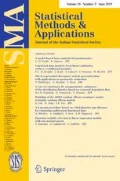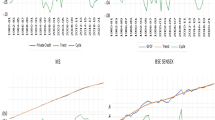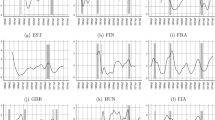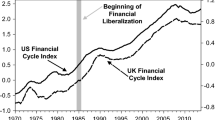Abstract
In this paper we examine the empirical features of both the business and the financial cycle in Italy. We employ univariate and multivariate trend-cycle decompositions based on unobserved component models. Univariate estimates highlight different cyclical properties (persistence, duration and amplitude) of real GDP and real credit to the private sector. Multivariate estimates uncover the presence of feedback effects between the real and the financial cycle. In addition, in the most recent period (2015–2016) the multivariate approach highlights a wider output gap than that estimated by the univariate models considered in this paper.











Similar content being viewed by others
Notes
Financial indicators do seem to have forecasting power for real activity, as shown in Borio and Lowe (2004), English et al. (2005), Hatzius et al. (2010), and Ng (2011). Furthermore, it has been argued that the estimation of potential output can benefit from the inclusion of information about the financial cycle, as captured by the behaviour of credit and property prices (Borio et al. 2013, 2014).
With regard to the Italian real cycle, Zizza (2006) estimated the Italian potential output using both univariate and multivariate unobserved components models, Bassanetti et al. (2010) provided a comparison of univariate structural time series models, while Busetti and Caivano (2016) estimated a bivariate output and Phillips curve model for the Italian economy.
Adapted by Harding and Pagan (2002) to deal with series sampled at the quarterly frequency.
Note that in the LLT the long-run growth rate (\(\Delta \tau _t\)) is driven by the shock to the slope component \(\zeta _t\) as well as by the first differences of the shock to the level component (\(\Delta \eta _t\)).
This specification is commonly referred to as “Seemingly Unrelated Time Series Equations” (SUTSE); see Harvey (1989, Chap. 8).
Under the restriction \(\rho _i=\rho \) and \(\lambda _i=\lambda \)\(\forall i\), the model features “similar cycles” (Harvey and Koopman 1997).
We thank an anonymous reviewer for pointing out this issue.
In our sample, results indicate that the IRW is preferred to the LLT specification. As we will show in the sequel of this section, in order to obtain a longer cycle and a smoother slope component in line with Rünstler and Vlekke (2018), it is necessary to impose restrictions on the slope variance; see Fig. 3 and the related discussion.
We also performed a rolling window exercise whereby at each iteration a new data point is added and the oldest data point discarded so as to maintain the length of the estimation window fixed. While this set-up tends to magnify time variation, we reached very similar conclusions to those reported in the main text. The only exception are the estimates based on sample windows including the period between the early 80’s and 2008, when the likelihood function shows two maxima, one local at \(\lambda =0.48\) (period \(\approx 13\) quarters) and one global at \(\lambda =0.15\) (period \(\approx 40\) quarters), confirming Busetti and Caivano’s (2016) findings.
See, e.g., Giorno et al. (1995), De Masi (1997) and Havik et al. (2014) for the methodologies employed by OECD, IMF and European Commission, respectively. The concept of a smooth potential output derives from the belief that most of the variance at business cycle frequencies is due to demand shocks while most of the variance at lower frequencies is due to supply shocks, as in Blanchard and Quah (1989). Nonetheless, this traditional view has been challenged by models in which demand shocks can have a long-lasting impact on output, as in Blanchard and Summers (1986), and by empirical analyses showing that large falls in output can be mostly driven by permanent shocks, as in Cerra and Saxena (2008).
We tried different calibrations and finally chose the one that, in our view, delivers an economically plausible long-run growth rate of real GDP.
See Banca d’Italia (2016).
Conversely, working with credit-to-GDP quarterly data ranging from 1974 to 2014, Galati et al. (2016) estimated a single financial cycle with a periodicity of 16.94 years (Table 1, p. 85).
This is mainly due to the fact that the volatility of \(\psi _{2,t}\) (measured by the signal-to-noise ratio) is much higher than the volatility of \(\psi _{1,t}\).
Similar conclusions can be reached by leaving out longer portions of real credit data at the end of the sample period. Results are available from the authors upon request.
Lastly, by jointly inspecting the cyclical estimates in Figs. 10 and 11, we note that when removing real credit data at the end of the sample, the financial gap tends to close; on the other hand, when removing real GDP data, the output gap tends to widen. These findings seem to suggest that the last years of data surprised to the downside with respect to real credit, while they surprised on the upside with respect to real output.
Producing the minimum mean squared linear estimator (MMSLE) of the state vector.
References
Aikman D, Haldane A, Nelson B (2015) Curbing the credit cycle. Econ J 125(585):1072–1109
Alessandri P, Bologna P, Fiori R, Sette E (2015) A note on the implementation of a countercyclical capital buffer in Italy. Banca d’Italia, Occasional papers (Questioni di economia e finanza), no. 278
Banca d’Italia (2016) Economic Bulletin No. 4 2016
Bank for International Settlements (2016) Long series on total credit to the non-financial sectors. Retrieved from http://www.bis.org/statistics/totcredit.htm
Bartoletto S, Chiarini B, Marzano E, Piselli P (2017) Business cycles, credit cycles, and bank holdings of sovereign bonds: historical evidence for Italy 1861–2013. Banca d’Italia, Economic History Working Papers (Quaderni di Storia Economica), no. 43
Bassanetti A, Caivano M, Locarno A (2010) Modelling Italian potential output and the output gap. Banca d’Italia, working paper series (Temi di Discussione), no. 771
Baxter M, King R (1999) Measuring the business cycle: approximate band-pass filters for economic time series. Rev Econ Stat 81(4):575–93
Bernanke B, Gertler M, Gilchrist S (1996) The financial accelerator and the flight to quality. Rev Econ Stat 78(1):1–15
Blanchard OJ, Summers L (1986) Hysteresis and the European unemployment problem, pp 15–90, in NBER Macroeconomics Annual 1986, vol 1
Blanchard OJ, Quah D (1989) The dynamic effects of aggregate demand and supply disturbances. Am Econ Rev 79(4):655–673
Borio C, Lowe P (2004) Securing sustainable price stability. Should credit come back from the wilderness? BIS working papers No. 157, Bank for International Settlements
Borio C (2012) The financial cycle and macroeconomics: what have we learnt? BIS working papers no. 395, Bank for International Settlements
Borio C, Disyatat P, Juselius M (2013) Rethinking potential output: embedding information about the financial cycle. BIS Working Papers No 404, Bank for International Settlements
Borio C, Disyatat P, Juselius M (2014) A parsimonious approach to incorporating economic information in measures of potential output. BIS Working Papers No 442, Bank for International Settlements
Borio C (2017) Secular stagnation or financial cycle drag. Keynote speech at the 33rd Economic Policy Conference, 5–7 March 2017, Washington DC
Bry G, Boschan C (1971) Cyclical analysis of time series: selected procedures and computer programs. NBER technical paper 20
Burns AM, Mitchell WC (1946) Measuring business cycles. National Bureau of Economic Research
Busetti F, Caivano M (2016) The trend-cycle decomposition of output and the Phillips curve: Bayesian estimates for Italy and the Euro area. Empir Econ 50(4):1565–1587
Carvalho V, Harvey AC, Trimbur T (2007) A note on common cycles, common trends, and convergence. J Bus Econ Stat 25(1):12–20
Cerra V, Saxena SC (2008) Growth dynamics: the myth of economic recovery. Am Econ Rev 98(1):439–57
Chen X, Kontonikas A, Montagnoli A (2012) Asset prices, credit and the business cycle. Econ Lett 117(3):857–861
Christiano L, Fitzgerald T (2003) The band-pass filter. Int Econ Rev 44(2):435–465
Claessens S, Kose MA, Terrones ME (2012) How do business and financial cycles interact? J Int Econ 87(1):178–190
Comin D, Gertler M (2006) Medium-term business cycles. Am Econ Rev 96(3):523–551
De Bonis R, Silvestrini A (2014) The Italian financial cycle: 1861–2011. Cliometrica 8(3):301–334
De Masi P (1997) IMF estimates of potential output: theory and practice. IMF Working Papers no. 97/177
de Winter J, Koopman SJ, Hindrayanto I, Chouhan A (2017) Modeling the business and financial cycle in a multivariate structural time series model. DNB Working Papers No. 573
Drehmann M, Borio C, Tsatsaronis K (2012) Characterising the financial cycle: don’t lose sight of the medium term! BIS Working Papers No. 380, Bank for International Settlements
Drehmann M, Tsatsaronis K (2014) The credit-to-GDP gap and countercyclical capital buffers: questions and answers. BIS Q Rev, March, pp 55–73
Durbin J, Koopman SJ (2012) Time series analysis by state space methods, 2nd edn. Oxford University Press, Oxford
English W, Tsatsaronis K, Zoli E (2005) Assessing the predictive power of measures of financial conditions for macroeconomic variables. BIS paper no. 22, pp 228–252, Bank for International Settlements
Galati G, Koopman SJ, Hindrayanto I, Vlekke M (2016) Measuring financial cycles with a model-based filter: empirical evidence from the United States and the euro area. Econ Lett 145(C):83–87
Giorno C, Richardson P, Roseveare D, van den Noord P (1995) Estimating potential output, output gaps and structural budget balances. OECD Economic Department Working Paper no. 157
Harding D, Pagan A (2002) Dissecting the cycle: a methodological investigation. J Monet Econ 49(2):365–381
Harvey AC (1989) Forecasting structural time series and the Kalman filter. Cambridge University Press, Cambridge
Harvey AC, Jaeger A (1993) Detrending, stylized facts and the business cycle. J Appl Econom 8(3):231–47
Harvey AC, Koopman SJ (1997) Multivariate structural time series models. In: Heij C, Schumacher JM, Hanzon B, Praagman C (eds) System dynamics in economic and financial models. Wiley, Chichester, pp 269–298
Harvey AC, Trimbur T (2003) General model-based filters for extracting cycles and trends in economic time series. Rev Econ Stat 85(2):244–255
Hatzius J, Hooper P, Mishkin F, Schoenholtz K, Watson M (2010) Financial conditions indexes: a fresh look after the financial crisis. NBER working papers, no. 16150
Havik K, Mc Morrow K, Orlandi F, Planas C, Raciborski R, Roeger W, Rossi A, Thum-Thysen A, Vandermeulen V (2014) The production function methodology for calculating potential growth rates and output gaps, European Economy—Economic Papers 2008–2015 no. 535, Directorate General Economic and Financial Affairs (DG ECFIN), European Commission
Jordà O, Schularick M, Taylor AM (2013) When credit bites back. J Money Credit Bank 45(2):3–28
Meller B, Metiu N (2017) The synchronization of credit cycles. J Bank Finance 82:98–111
Ng T (2011) The predictive content of financial cycle measures for output fluctuations. BIS Q Rev, June, pp 53–65
Rey H (2013) Dilemma not trilemma: the global financial cycle and monetary policy independence. Federal Reserve Bank of Kansas City, proceedings—economic policy symposium—Jackson Hole
Rünstler G (2004) Modelling phase shifts among stochastic cycles. Econom J 7(1):232–248
Rünstler G, Vlekke M (2018) Business, housing, and credit cycles. J Appl Econom 33(2):212–226
Schularick M, Taylor A (2012) Credit booms gone bust: Monetary policy, leverage cycles, and financial crises, 1870–2008. Am Econ Rev 102(2):1029–61
Schüler Y, Hiebert P, Peltonen T (2015) Characterising the financial cycle: a multivariate and time-varying approach. Working Paper Series, No 1846, European Central Bank, Frankfurt am Main
Schüler Y, Hiebert P, Peltonen T (2017) Coherent financial cycles for G-7 countries: why extending credit can be an asset. Working paper series, No 43, ESRB, Frankfurt am Main
Shephard NG, Harvey AC (1990) On the probability of estimating a deterministic component in the local level model. J Time Ser Anal 11(4):339–347
Silvestrini A, Zaghini A (2015) Financial shocks and the real economy in a nonlinear world: from theory to estimation. J Policy Model 37(6):915–929
Strohsal T, Proaño C, Wolters J (2015a) Characterizing the financial cycle: Evidence from a frequency domain analysis. Discussion Paper Series, No 22, Deutsche Bundesbank, Frankfurt am Main
Strohsal T, Proaño C, Wolters J (2015b) How do financial cycles interact? Evidence for the US and the UK. Discussion Paper Series, No 24, Sonderforschungsbereich 649, Humboldt University, Berlin
Verona F (2016) Time-frequency characterization of the US financial cycle. Econ Lett 144:75–79
Zizza R (2006) A measure of output gap for Italy through structural time series models. J Appl Stat 33(5):481–496
Author information
Authors and Affiliations
Corresponding author
Additional information
Publisher's Note
Springer Nature remains neutral with regard to jurisdictional claims in published maps and institutional affiliations.
We would like to thank the Editor-in-Chief Tommaso Proietti and two anonymous reviewers, as well as Marco Bernardini, Fabio Busetti, Simone Emiliozzi, Lucia Esposito, Giuseppe Grande, Stefano Neri, Gerhard Rünstler, Stefano Siviero, Fabrizio Venditti, participants at the CFE 2017 Conference (London, 16–18 December 2017) for their constructive and valuable suggestions. We are also grateful to Gerhard Rünstler and Marente Vlekke for sharing their Matlab codes in the framework of the WGEM expert team on “Links between real and financial cycles”. Any remaining errors are ours. The views expressed herein are those of the authors and do not necessarily reflect those of the Institution they represent.
Appendices
Appendix
Estimation, filtering and smoothing
Consider the following linear Gaussian state space model:
where \(\varvec{y}_t\) is the \(N\times 1\) vector of observed variables, \(\varvec{\varepsilon _t}\) is the \(N\times 1\) vector of measurement errors, \(\varvec{\alpha }_t\) is the \(m\times 1\) vector of state variables and \(\varvec{\eta }_t\) is the corresponding \(m\times 1\) vector of innovations. The two innovation vectors are assumed to be Gaussian distributed and uncorrelated for all time periods, that is, \(E(\varvec{\varepsilon }_t \varvec{\eta }_s')=\varvec{0} \)\(\forall t,s\); this assumption can be relaxed at the cost of a slight complication in some of the filtering formulae. The initial value of the state vector is also assumed to be Gaussian \(\alpha _1 \sim {\mathcal {N}}(\varvec{a}_1,\varvec{P}_1)\) and uncorrelated \(\forall t\) with \(\varvec{\varepsilon _t}\) and \(\varvec{\eta _t}\).
Following Harvey (1989), conditional on the information set \(\varvec{Y}_{t-1}=\{\varvec{y}_{t-1},...,\varvec{y}_1\}\) and on the vector of parameters \(\varvec{\theta }\), the observations and the state vector are Gaussian, i.e., \(\varvec{y}_t|(\varvec{Y}_{t-1};\varvec{\theta }) \sim {\mathcal {N}} (\varvec{Z} \varvec{a}_t, \varvec{F}_t)\) and \(\varvec{\alpha }_t|(\varvec{Y}_{t-1};\varvec{\theta }) \sim {\mathcal {N}}(\varvec{a}_t, \varvec{P}_t)\). Therefore, it follows that the log-likelihood function for the full vector of observations \(\varvec{y}=(\varvec{y}_1',\dots ,\varvec{y}_n')'\) can be expressed by the prediction error decomposition:
The prediction error \(\varvec{v}_t\), its covariance matrix \(\varvec{F}_t\), the state vector conditional mean \(\varvec{a}_t\), and its mean square error (MSE) matrix \(\varvec{P}_t\) are estimated optimallyFootnote 18 by means of the Kalman Filter (KF):
with initial values \(\varvec{a}_1\) and \(\varvec{P}_1\). Regarding the initialization of the state vector, a diffuse initial condition is used for the trend component, while the cyclical component is initialized with the unconditional moments. Once the vector of parameters \(\varvec{\theta }\) is estimated by ML, the unobserved components can be extracted from the observations using the KF and the associated Kalman smoother. Specifically, \(\varvec{a}_{t}=E(\varvec{\alpha }_{t}|\varvec{Y}_{t-1},\varvec{\theta })\) is the so-called predictive filter and \(\varvec{P}_{t}=E[(\varvec{a}_{t}-\varvec{\alpha }_{t})(\varvec{a}_{t}-\varvec{\alpha }_{t})']\) is the associated MSE, while the real-time filter is \(\varvec{a}_{t|t}=E(\varvec{\alpha }_t|\varvec{Y}_t, \varvec{\theta })\) and its MSE is \(\varvec{P}_{t|t}=E[(\varvec{a}_{t|t}-\varvec{\alpha }_t)(\varvec{a}_{t|t}-\varvec{\alpha }_t)']\). It is worth stressing that in this linear model the MSEs are independent from the observations, thus they are also the unconditional covariance matrices associated with the conditional mean estimators; see Harvey (1989, Sect. 3.2.3).
The smoother algorithm allows us to estimate the state vector given all the available information, namely \(\varvec{a}_{t|n}=E(\varvec{\alpha }_{t}|\varvec{Y}_n,\varvec{\theta })\) and the associated MSE \(\varvec{P}_{t|n}=E[(\varvec{a}_{t|n}-\varvec{\alpha }_{t})(\varvec{a}_{t|n}-\varvec{\alpha }_{t})']\). It is a backward recursion:
with initial values \(\varvec{r}_n=\varvec{0}\) and \(\varvec{N}_n=\varvec{0}\). For more details see Harvey (1989, Sect. 3.6) and Durbin and Koopman (2012, Sect. 4.4).
Rights and permissions
About this article
Cite this article
Bulligan, G., Burlon, L., Delle Monache, D. et al. Real and financial cycles: estimates using unobserved component models for the Italian economy. Stat Methods Appl 28, 541–569 (2019). https://doi.org/10.1007/s10260-019-00453-1
Accepted:
Published:
Issue Date:
DOI: https://doi.org/10.1007/s10260-019-00453-1




